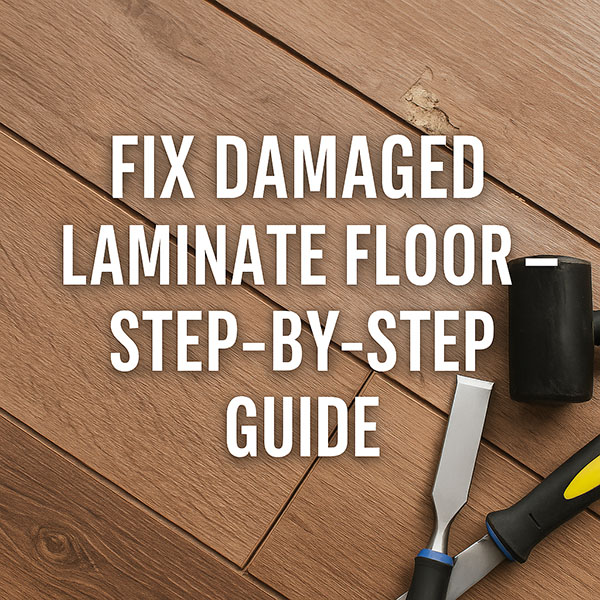Ultimate Guide: How to Fix Damaged Laminate Flooring Like a Pro!
Is your laminate flooring showing scratches, dents, or even signs of water damage? Don’t worry—you can fix damaged laminate floor problems without replacing the entire surface. With the right tools, a bit of time, and some proven techniques, you’ll restore your floors to their original charm. This guide covers everything from small scratch repairs to plank replacements, helping you choose the best solution for your situation. Ready to give your home a fresh look? Let’s dive in!
Understanding Laminate Flooring: Structure and Benefits
Laminate flooring is made of several layers: a tough wear layer, a decorative surface that mimics real wood, a high-density fiberboard (HDF) core, and a stabilizing backing. Together, these layers create a strong, stylish, and budget-friendly alternative to hardwood. With proper care, laminate can last many years and enhance the look of any room. To get the most out of your flooring, it’s important to understand how each layer reacts to damage and what repair options are available.
Common Types of Damage to Laminate Flooring
Before you fix damaged laminate floor issues, it helps to know the most common problems:
- Scratches and scuffs from pets, furniture, or shoes
- Dents caused by heavy objects
- Warping or buckling due to moisture exposure
- Chipped corners from accidental impacts
- Faded color from direct sunlight
Each of these issues has a specific repair method, and most can be handled with simple tools and materials available at your local hardware store.

Tools and Materials Needed for Repairs
To successfully fix your laminate flooring, gather these essentials first:
- Laminate repair kit (wax or putty for scratches)
- Wood glue
- Fine-grit sandpaper
- Cloth or microfiber mop
- Utility knife
- Replacement planks (if needed)
- Shims or spacers for stability
Step-by-Step Guide to Repairing Scratches and Scuffs
Light scratches are easy to fix with a laminate repair kit. Simply clean the area, apply the wax or putty in the color that matches your floor, and buff gently with a cloth. For deeper scratches, repeat the process until the mark blends in. You can also apply furniture pads to chairs and tables to prevent future scratches.
How to Fix Warped or Buckled Laminate Flooring
Warping usually occurs when moisture seeps into the HDF core. Start by identifying the source of moisture—whether it’s from leaks, spills, or humidity. Once fixed, remove the warped planks, let them dry, and replace if necessary. To avoid future issues, consider using quality underlay with moisture protection.
Replacing Damaged Planks: A Comprehensive Approach
When a plank is beyond repair, replacement is the best option. Remove the surrounding boards carefully, unlock the damaged plank, and click a new one into place. This approach restores both appearance and structural stability. For high-traffic rooms, it’s wise to keep extra planks from your original installation for quick fixes.
Preventative Measures to Avoid Future Damage
Prevention is key to maintaining your floors. Use rugs in busy areas, clean with a microfiber mop and plain water, and avoid harsh chemicals. Adding felt pads under furniture legs also helps protect against scratches. For homes with pets, trim claws regularly to minimize surface damage.
When to Call a Professional: Signs You Can’t DIY
Some issues go beyond DIY fixes. If you notice extensive water damage, large-scale warping, or structural issues with your subfloor, it’s time to bring in a professional installer. Their expertise ensures that your repair is both safe and long-lasting, protecting your investment in the long run.
Cost Analysis: DIY Repairs vs. Hiring a Professional
DIY fixes can cost as little as a few hundred rand for basic tools and kits, making them budget-friendly. Professional repairs, however, may range from a few thousand rand depending on the severity of the damage. While DIY saves money upfront, professional services often deliver a longer-lasting solution.
Conclusion: Maintaining Your Laminate Flooring for Longevity
Learning how to fix damaged laminate floor surfaces empowers you to extend their lifespan and maintain a beautiful home. With proper cleaning, timely repairs, and preventive care, your floors can remain stylish and durable for years. For more insights, check out our full guide on vinyl wood flooring vs laminate wood flooring to compare other durable flooring options. With the right care, your laminate floors will stay squeak-free, damage-free, and stunning.
FAQs About Fixing Damaged Laminate Floors
Can you fix water-damaged laminate flooring?
Yes, but only if the damage is minor. Severe swelling usually requires plank replacement.
What is the best way to repair small scratches?
Use a laminate floor repair kit with matching wax or putty for a seamless finish.
Is it cheaper to replace or repair laminate flooring?
Repairing scratches or dents is usually cheaper. Full plank replacement should only be done when damage is extensive.
Can damaged laminate floors lower home value?
Yes. Visible scratches, warping, or dents can reduce your home’s appeal. That’s why it’s essential to fix them quickly.

Leave a Reply